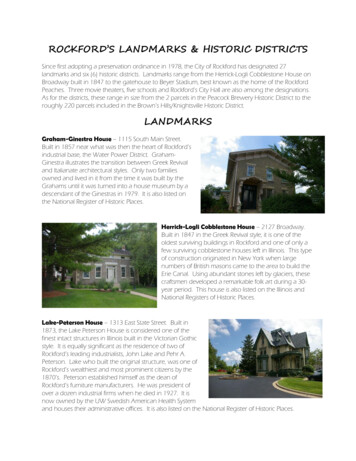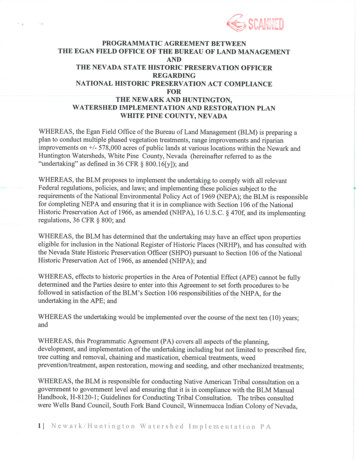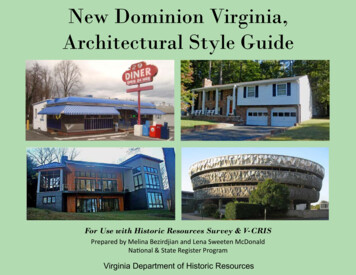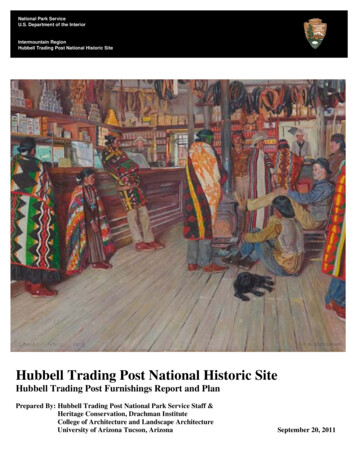
Transcription
ROCKFORD’S LANDMARKS & HISTORIC DISTRICTSSince first adopting a preservation ordinance in 1978, the City of Rockford has designated 27landmarks and six (6) historic districts. Landmarks range from the Herrick-Logli Cobblestone House onBroadway built in 1847 to the gatehouse to Beyer Stadium, best known as the home of the RockfordPeaches. Three movie theaters, five schools and Rockford’s City Hall are also among the designations.As for the districts, these range in size from the 2 parcels in the Peacock Brewery Historic District to theroughly 220 parcels included in the Brown’s Hills/Knightsville Historic District.LANDMARKSGraham-Ginestra House – 1115 South Main Street.Built in 1857 near what was then the heart of Rockford’sindustrial base, the Water Power District. GrahamGinestra illustrates the transition between Greek Revivaland Italianate architectural styles. Only two familiesowned and lived in it from the time it was built by theGrahams until it was turned into a house museum by adescendant of the Ginestras in 1979. It is also listed onthe National Register of Historic Places.Herrick-Logli Cobblestone House – 2127 Broadway.Built in 1847 in the Greek Revival style, it is one of theoldest surviving buildings in Rockford and one of only afew surviving cobblestone houses left in Illinois. This typeof construction originated in New York when largenumbers of British masons came to the area to build theErie Canal. Using abundant stones left by glaciers, thesecraftsmen developed a remarkable folk art during a 30year period. This house is also listed on the Illinois andNational Registers of Historic Places.Lake-Peterson House – 1313 East State Street. Built in1873, the Lake Peterson House is considered one of thefinest intact structures in Illinois built in the Victorian Gothicstyle. It is equally significant as the residence of two ofRockford’s leading industrialists, John Lake and Pehr A.Peterson. Lake who built the original structure, was one ofRockford’s wealthiest and most prominent citizens by the1870’s. Peterson established himself as the dean ofRockford’s furniture manufacturers. He was president ofover a dozen industrial firms when he died in 1927. It isnow owned by the UW Swedish American Health Systemand houses their administrative offices. It is also listed on the National Register of Historic Places.
Coronado Theatre – 314 North Main Street. Built in1927, the Coronado is considered one of the bestpreserved atmospheric “movie places” of the 1920’s.The interior contains a mixture of exotic motifs –Spanish, Italian and French architecture; Italiansculpture; and Chinese, Egyptian and Persian art. Thetheater was virtually untouched until a majorrenovation carried out in 1999-2000 at a cost of 18.5million. The renovation resulted in combining theoriginal Coronado structure with the Liebling Buildingnext door (see below) to provide sufficient backstageand rehearsal space, something the original theaternever had. The original structure is also listed on theIllinois and National Registers of Historic Places.Freeman School – 910 Second Avenue. This wasthe second school erected on this site when itwas built in 1893. The first school, Adams School,was razed in 1893 to make room for thisstructure. It was named for Henry Freeman,principal of the Adams School from the mid1860’s to 1880. During the 1930’s and 40’s,Freeman School became synonymous withspecial education in Rockford, housing numerousprograms for children with physical and mentaldisabilities. The school was renamed “FreemanSquare” in the early 1980’s when it wasconverted to office use.Midway Theatre – 721 East State Street. Oneof the largest movie houses built when itopened in 1918, the Midway seats 2,000.Constructed in the Spanish Renaissance style, itoriginally contained not only a movie theaterbut also four storefronts, twenty apartments onthe upper floors, and a basement that containeda bowling alley and recreation area for CampGrant soldiers during World War I. It functionedas a movie theater until August 1980 when itwas almost destroyed by fire. It was restoredshortly afterwards for use as a live entertainmentvenue, most notably as home to the RockfordSymphony Orchestra until it moved to theCoronado after its restoration. The Midway is asignificant part of the East Rockford (National Register) Historic District.
Anderson Building – 803 North Church Street.Originally built as the home of Peter and AlmiraCampbell, the Anderson Building is an elaborate exampleof the mid-19th century Italianate Villa style. It wasrestored as close to its original design and character aspossible in the late 1970’s when it served for a time aspart of the then nationally famous Rockford enterprise,Connie’s Flowers and Dress Shop. It served as offices ofAnderson Consolidated Industries for about 20 years andis now home to Homestart, a housing counseling andhomebuyer education company.Tinker Swiss Cottage Museum – 411 Kent Street. Built in1869 as the home of Robert Tinker, a leading Rockfordbusiness man of the time, the Cottage is an exceptionalexample of vernacular, picturesque cottage style. The 26room frame cottage sits high on a bluff overlooking KentCreek near the site of Rockford’s first industry, GermanicusKent’s sawmill. It was designed by architect GeorgeBradley founder of the locally known firm of Bradley &Bradley. Most of the Cottage’s original furnishings remain.It is also listed on the National Register of Historic Places.Burpee Museum of Natural History – 737 & 813 North Main Street. These two buildings actuallyhoused separate museums when they were designated as landmarks in 1983. The building at 737was home to the Burpee Art Museum which has since moved into the Riverfront Museum Park andhas been renamed the Rockford Art Museum. The 737 building then joined the 813 building as homeof the Burpee Museum of Natural History. 737 was built in 1854 by local craftsmen as the home ofJohn S. Coleman, a local banker and member of City Council. Subsequent owners were John P.Manny and William Nelson, both Rockford Industrialists. The Burpee family bought it in 1935 withplans to develop it into an art center for Rockford. A new wing designed by A. Reyner Eastman wasadded in 1939 to provide an auditorium, meeting room and additional gallery space. This wasremoved in 1998 and a much larger addition designed by Gary Anderson & Associated wasconstructed. The house at 813 North Main Street was built in 1893 by William Fletcher Barnes, one ofthe founders of the W.F. & Barnes Company. Mr. Barnes and his family were the only people toactually live the house until it was sold to the Rockford Park District in 1937. It provided office space forthe Park District as well as museum space until 1971 when the entire building was turned over tomuseum use.
John Erlander Home – 404 South Third Street.The home was built in 1871 as the residence ofJohn Erlander, one of Rockford’s earliest settlers,and a business and civic leader. It is an excellentexample of the 19th century Italianate architecturestyle popular at that time. Since 1952 it hasserved as home to Rockford’s Swedish HistoricalSociety and a museum for Swedish artifacts, earlyRockford-made furniture and historical records. Itis located in the Haight Village Historic Districtwhich is both a local and National Register district.Times Theatre – 222-230 North Main Street.One of two remaining examples of Art Modememovie theaters in Rockford, the Times, whichincludes storefronts on Main Street, was built in1938. At its opening that year, the Times boastedof “up to the minute” acoustical treatments andtemperature control, as well as 1,000 seats in thetheater that were mothproof and fireproof. Itceased operation as a movie theater around1980 and operated as a nightclub and restauranton and off for a few years. It is currently vacant.7th Street Train Depot – 701-703 7th Street. Thesignificance of this passenger depot built in 1911lies in the fact that it was one of two olderremaining train depots in Rockford at the time itwas designated, and the only passenger depot. Itwas the last restorable Chicago & NorthwesternDepot in the Kenosha District (northern Illinois andsouthern Wisconsin). Designed by renownedrailroad architect Charles Frost and constructed bylocal builder Emil Schmeling, it recently was thehome to the Midtown District’s office prior to theirrelocation to the Lantow Lofts Building.Four Squires Building – 203 West State Street. This is actuallytwo buildings combined into one in the 1920’s by W.T. Grantwhen they replaced the original Italianate design with theexisting Art Deco façade. Its significance lies partly in the qualityof the Art Deco design, through which it represents a period inour history when retailers tried to make a positive corporatestatement through architecture. It is also important as thecenterpiece of the last block of West State Street in downtownRockford that is still intact. This site is currently home to “TheDistrict” bar and grill.
West Middle School – 1900 North RocktonAvenue. This was originally built as WestHigh School in 1939 as part of the WPAproject which also resulted in theconstruction of East High School. Beforethen, there had only been one high schoolin the Rockford School District, Central HighSchool on South Madison. While the basicdesign was by Gilbert Johnson, the exteriorfaçade was designed by Jesse Barloga inthe Art Modeme style. Its local significancealso lies in the fact that it was fully integratedfrom the time it first opened its doors. Westwas changed to a middle school in 1989.East High School – 2929 Charles Street. East HighSchool was built at the same time as West High, also aWPA project. The same basic interior design by GilbertJohnson was used, but this time the exterior façade wasdesigned by Willis Hubbard. East was also consideredan excellent example of Art Modeme architecture, and afocal point from the community from its beginning. Theschool recently expanded and updated all the windowsas a part of a renovation project.Garrison School – 1105 North Court Street. Theoriginal part of Garrison was built in 1887 with aRomanesque façade and Queen Anne details.Although the school has had additions made to itthat are not compatible with the original design, thefact that the original part of the school is an excellentexample of a late Victorian elementary schoolcoupled with the fact that the original portion of theschool is intact provided sufficient grounds forlandmark designation. The school was redevelopedinto residential units in 2007 and new townhomeswere also constructed on the rest of the site.
Liebling Building – 330 North Main Street. Betterknown locally as the Jackson Piano Building, this is anexcellent example of the Art Deco style with a stunningtribute to the artistry of terra cotta masons at the time itwas built in 1930. Art Deco elements present in thebuilding include its overall vertical design, stylizeddecorations and extensive use of terra cotta. Thebuilding’s interior was incorporated into the CoronadoTheatre during its 1999-2000 renovation.Shumway Market Building – 713 East StateStreet. A unique Rockford structure, the ShumwayMarket was built in the 1920’s. Its uniquenessstems partly from the purpose for which it was built– to serve as a public “comfort station” - and partlyfrom its simple but elegant design. Its importancealso lies in it connection to the Shumway FarmersMarket that operated in the area behind sinceRobert Shumway donated the land to the City ofRockford for that purpose in 1904. Completelyrestored in 1987 by the Rockford Area Conventionand Visitors Bureau, it currently houses theRockford Area Arts Council.Illinois National Guard Armory – 605 NorthMain Street. Built in 1937, the Armory wasdesignated as a local landmark and listed onthe National Register of Historic Places becauseof its role as a focal point within thecommunity for a long period of time, its statusas the long-time home of the local contingentof the Illinois National Guard, and itsoutstanding architecture. It was designed by alocal firm (Bradley & Bradley) and built by alocal contractor, Sjostrom & Sons, which is still in business today. In addition to being an excellentexample of the 1930’s style of Neo-Gothic Art Deco architecture, it has incorporated into the first use ofwhat is known as rigid frame construction. This vaulted the fieldhouse portion of the building with asingle unified steel frame which was also connected under the floor from one side of the building tothe other. At the time, it was the first attempt to use this type of construction. Bradley & Bradleyreceived national recognition for the design which was the precursor to pre-engineered steel buildingsthat are erected today.
Rockford City Hall – 425 East State Street. What isnow Rockford’s City Hall was originally built as theManufacturer’s National Bank in 1926. At the time ofconstruction, the eight-story building reachedhighest peak in the City, towering over thesurrounding one- and two-story buildings. Designedby the firm of Peterson & Johnson, the building hadan exterior façade of limestone and a base ofpolished granite with Corinthian pilasters rising fromthe street. Other architectural features included anelaborate cornice as well as dentils, shields and otherterra cotta ornamentation. Spotlighted by floodlightsat night, it was referred to as the “monarch of theboulevard” during its use as a bank. Like many otherlocal banks, however, Manufacturer’s was unable toweather the Great Depression and closed in 1931.Although many offices remained rented out tovarious types of professionals after the bank closed,the space itself remained vacant for several years.Upon passage of a referendum, the City purchasedthe building in 1937 for 125,000. However, it wasseveral years before the building was limited tostrictly City business; it wasn’t until 1968 that all departments except for Police and Fire were located inthe building. By the 1970’s, the building was overcrowded and in need of major repair. It wasn’t until1988 that the decision was made to renovate the building, restoring the first floor lobby and adding atwo-story annex to the west. Architect for the project was Ware Associates with construction beingdone by Sjostrom & Sons. The 6.6 million project was completed in early 1994. City Hall is also asignificant part of the East Rockford (National Register) Historic District.Winnebago County Courthouse Annex –403 Elm Street. This Classical Revivalbuilding was constructed in 1916-1917 asan annex to the Winnebago CountyCourthouse built in 1876. Although it isrelatively small, it has a monumentalappearance to it, especially in comparisonwith surrounding buildings. The threeprimary facades are symmetrical, markedwith clear divisions made by eitherengaged columns or pilasters. In addition,windows repeat the same pattern on allthree primary facades, increasing thesymmetrical nature of the design. Overall,the building represents the Classical style ofthe era in which it was built. It is,unfortunately, the last remaining example of the type of design on what was Courthouse Square.
Chick House – 119-123 South Main Street. Knownbest in recent years as the home of Rockford OfficeSupply, the Chick House was built in 1857 and is oneof only three remaining pre-Civil War commercialbuildings remaining in downtown Rockford. Itgained the name “Chick House” after purchase byThomas Chick in 1888. While its upper floors wereused as hotel rooms, the first floor had a variety ofuses including a saloon, a hardware store, and theoffice supply store that still occupies the northernthird of the building. It served as a hotel until 1951.The Chick House is also listed on the NationalRegister of Historic Places.Elks Club Building – 210 West Jefferson Street.Constructed in 1912 as the home of BPOE #64,the Elks Club building shows several criticalelements of the Prairie Style in its horizontal linesand detailing. More classical elements includethe arched windows and porche cochere. It wasdesigned by Lawrence Buck, one of fourarchitects who worked with Frank Lloyd Wrightat Steinway Hall. He is not as well-known as theothers due largely to a lack of surviving familymembers to carry on his name and history. Buckwas primarily known for designing residences,making this structure a departure from hisnormal line of work. The building is also listed on the National Register of Historic Places.Abraham Lincoln Junior High School – 1500 CharlesStreet. Lincoln is an exceptional example of the ClassicalRevival style of architecture. The main structure consists of athree-story building with basement, plus a rectangular onestory building which connects to the main building by abasement corridor. The school was designed by GilbertJohnson, one of Rockford’s leading architects of the time.Construction began on the school in September 1925 andfinished two years later in September 1927. It is still in activeuse as a middle school and recently installed all newwindows as a part of a renovation project.
Beyer Stadium Ticket Gatehouse – 311 15thAvenue. The historical importance of the Gatehousestems from two factors. First, the Gatehouse andsteps are all that remain of Beyer Stadium, home ofthe Rockford Peaches. The Peaches were a chartermember of the All-American Girls Professional SoftballLeague, the first professional sports organization forwomen in the United States. In addition to serving ashome to the Peaches, Beyer Stadium was also whereEast and West High Schools played their footballgames until the late 1960’s. The stadium hosted otherevents as well, such as the Rockford Rams semi-profootball team, until 1992 when the stadium wasdemolished. Over the years, Beyer broughtthousands of Rockford residents together to watchboth professional and amateur sports events.Booker Washington Center – 524 Kent Street and1005 South Court Street. This site earned locallandmark status in December of 2015. The historicimportance of the Booker Washington Center stemsfrom two factors. First, this was the site of Kent Schoolwhich was the third established public school inRockford in 1858. The school was designed byGeorge Bradley, the founder of Bradley & Bradley.The school was 3 stories tall and constructed oflimestone from the Rockford Quarry. The school thenbecame the site of the Booker Washington Center in1936. The second factor is the social significance ofthis site as a center for Black culture which started in1916 with the founding of the Colored Servicemen’sClub which was formed at Camp Grant. The name of the club was changed to the Booker T.Washington Center in 1919 to aid black servicemen coming home from World War I. BWC eventuallypurchased the site from the Rockford School District in 1942. The center was again used to providefood and recreation to black soldiers from Camp Grant during World War II. The center had twoadditions made to it that were not compatible with the original design. Both of those additions weredestroyed by fire in 1980 and the upper floors of the former school were destroyed as well. However,the first floor of the original school remains intact. The center was rebuilt in 1983 and still serves thecommunity today.
HISTORIC DISTRICTSHaight Village. Rockford’s first local historic district, HaightVillage includes the area bounded by South Madison,Walnut and Kishwaukee Streets and the railroad to thesouth. This area formed the southeast corner of the newlyincorporated Rockford in 1839 and is the only section of theoriginal square mile settlement to remain intact as aresidential area. It was Rockford’s most fashionableneighborhoodduring the late19th and early 20th centuries. Taken as a whole, thearchitecture of its homes provides a visible record ofRockford’s growth from a small settlement to a late 19thcentury industrial city. The style and scale of the homeshere range from modest Gothic and Greek Revivalhomes that are Haight Village’s oldest structures, to theflamboyantQueen Anne homes of the 1890’s that were built as visibleexpressions of their owners’ economic success. Together,these show Rockford’s evolution from a struggling village to awealthy center of manufacturing. It is also listed on theNational Registerof Historic Places.Garfield Avenue Historic District. The 600 through 900blocks of Garfield Avenue on Rockford’s northwest side make upthe City’s second historic district. Homes in the District representa variety of architectural styles, some dating back to the turn ofthe last century.Many of thehome representexamples ofcraftsmanshipunique to the early 1900’s. Prominent individuals whohave lived on this part of Garfield Avenue include G. R.Smith, son of the founder of Smith Oil Corporation;Arthur Ziock, owner of Ziock Sock Mills; William H.Barnes, developer of the Garfield Avenue area; and G.David Sundstrand, one of the founders of the Sundstrand Corporation and the inventor of theSundstrand adding machine.
Indian Terrace Historic District. The Indian TerraceHistoric District occupies roughly six acres on Rockford’sriverfront, starting with Beattie Park and extendingnorthward to the southern edge of the Armory property. Itexists today as an intact, early 20th century urbanneighborhood. It derives its character not from a largenumber of structures of landmark quality, but from ahomogeneous blend of architectural styles with similarmassing, scale and proportion. The District also containsvisual evidence of another culture in the effigy mounds constructed by Native Americans in what isnow Beattie Park. The mounds in this group represent the southern extent and one of the last intactsites of the lateprehistoric EffigyMound Culturein Illinois. Thegroup consists ofconical mounds,a linear moundand a turtleeffigy mound.The Rockford Park District has created an informational area about the mounds in the middle of thepark. Because of these mounds, Beattie Park is also listed on the National Register of Historic Places.Brown’s Hills/Knightsville Historic District. The Brown’sHills/Knightsville Historic District lies to the north of Rockford’sdowntown on the south side of Sinnissippi Park. It was settledin the 1850’s and 1860’s by Horace Brown, for whomBrown’s Hills is named, and Major Elias Cosper whosubdivided his land with the aid of B.A. Knight, establishingKnightsville in 1889. The latter was a Swedish communityestablished for the sole purpose of providing housingadjacent to the Skandia Furniture Company (located on theother side of North Second Street south of where the Park District’s Nichols Conservatory now sits) forthe Swedish workers. The population consisted of five families, four of them interrelated, and therelatives they brought over from Sweden. In 1922, Brown’s Woods, south of Knightsville, wassubdivided and became the address of several prominent Rockfordians. The District includes a varietyof architectural styles, ranging from Victorian-era farmhouses to bungalows to several home designedby Jesse Barloga, including one of built for himself. Despite the variety of homes, the District hasbecome a closely knit neighborhood, still isolated from the rest of the City by natural boundaries.
Northeast State & Main Historic District. This uniquehistoric district differs from the other four in that it is comprisedsolely of commercial buildings as opposed to predominantlyresidential ones. Its primary significance lies in the fact that itcontains the last block on downtown West State Street that isstill intact with pre-Urban Renewal buildings. Collectively, thebuildings represent a period of history when individualbuildings with their own individual architectural integritystood side by side. Individually, they possess a variety ofhistorical and architectural qualities with one – the Four Squires Building – being designated as anindividual landmark as well.Peacock Brewery Historic District. Rockford’s most recently created historic district is a testament tothe historic brewing industry in Rockford. It consists of only two buildings, the Peacock Brewery andthe Brew Master’s house. The original Brew House building, also known as the Ice House, wasconstructed in 1857 and consists of masonry bearing stone and brick material on the exterior.Additions were added to the original structure including the Malt House, the Brew House and theBottling House. The brewery buildings are largely intact with original architectural details andmaterials. The Brew Master’s house is a Greek Revival Design and is constructed of indigenous locallimestone. It was built from 1845-1846. An addition for the office of the brewery was built in 1902and consists of brick masonry. The Brew Master’s house has managed to maintain its architecturalintegrity for over 150 years. This historic district is also listed on the National Register of Historic Places.
Liebling Building – 330 North Main Street. Better known locally as the Jackson Piano Building, this is an excellent example of the Art Deco style with a stunning tribute to the artistry of terra cotta masons at the time it was built in 1930. Art Deco elements present in the buildi










